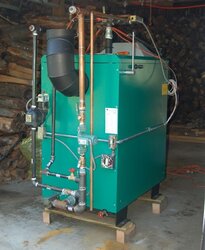I brought home an EKO 40 and two 500 gallon propane tanks last night! What are my options for piping the main circulation loop. I have a pair of adapters that got me from 2" british to 2" npt in iron pipe. Is this section typically all done in iron pipe? I have no means to cut/thread the pipe to custom lengths, so some sweat system would work better for my limited tools and skills. Boilers I've seen usually have iron pipe...are there reasons to avoid copper for this application?
Edit: A second question....should I attempt to drill/tap the propane tank where needed, or cut a hole and weld a threaded flange to the surface. I will need to borrow equipment to do either.
Edit: A second question....should I attempt to drill/tap the propane tank where needed, or cut a hole and weld a threaded flange to the surface. I will need to borrow equipment to do either.


